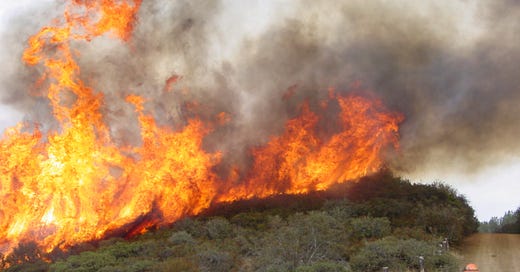Science confirms that long-term drought intensifies chaparral wildfires
Scientists used satellite imagery to gage the mortality of chaparral after years of drought
I’ll be taking a break, going on a brief vacation, this week. There will be no publication of The Green Dispatch on Friday, September 2nd or Monday, September 5th. I’ll have something out, probably a “News You can Use” for Friday the 9th.
A new study, just published this month, looked at the effects that the long-term drought in California and the Southwest has had on wildfires. The scientists concluded that the drought caused a great many of the shrubs and trees in the chaparral to die out and those dead and dying branches and twigs exacerbated fire conditions for two recent mega fires. The drought caused the fires to be larger than they would have been otherwise.
A severe drought started in California in 2011, lasting at least until 2017, with some saying that the drought has continued to this day. Using satellite imagery, the scientists estimated how much the longstanding drought has dried up or killed chaparral plants by measuring how green the landscape was. The less green, the more dried up the plants were, with more dead shrubs and trees.
The team looked at imagery of the chaparral in the years before it burned in two mega fires, the 2017 Thomas Fire and the 2018 Woolsey Fire. The Woolsey Fire burned 96,949 acres of Los Angeles and Ventura counties. The Thomas Fire consumed 281,893 acres of Ventura and Santa Barbara counties and remains historically one of California’s largest wildfires.
Fires are part of the ecology of chaparral. In southern California, as is the case with Mediterranean climates world-wide, six months of cool, wet weather lasting through winter and spring are followed by six months of drought from summer through fall. It is at the end of that dry spell, usually October, when wildfire most often occurs in California. Besides the dry conditions, fires are spurred by Santa Anas, which are very hot and strong (sometimes over 60 mph) winds that blow in from the desert. Climate change is complicating this pattern, with more frequent fires and fires occurring in other times of the year.
Now here’s the thing. Fire is part of chaparral ecology, with the plants of chaparral having evolved strategies to survive fire. Some resprout post fire from their root burls; others have seeds that germinate when they are exposed to fire’s smoke or heat. Yet historically, before California’s great population increase over the last 170 years, fire had been relatively rare in the chaparral. occurring every 20 to 160 years, sometimes even less frequently than that. This is in great contrast to the frequency of fire in western forests, which usually recurs about every 10 to 20 years. Another difference between fires in chaparral and forests is that naturally occurring forest fires are low-level ground fires that consume only a portion of the forest and not killing many mature trees. Chaparral fires are crown fires in which almost all vegetation is consumed.
Keep reading with a 7-day free trial
Subscribe to The Green Dispatch to keep reading this post and get 7 days of free access to the full post archives.



